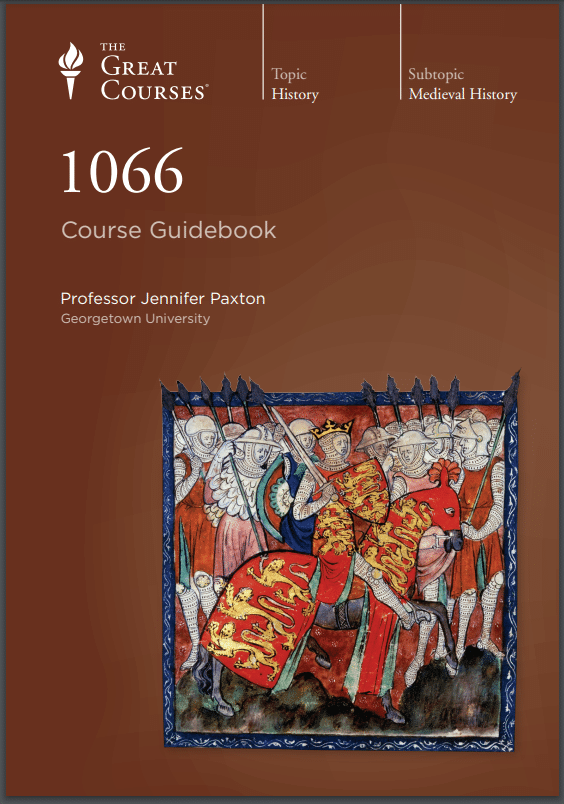Please scroll down for an English review.
הספר השני בסידרת ההרצאות של ד"ר ג'ניפר פקסטון שעוסק בהיסטוריה של אנגליה.
הספר הוא סידרה של 6 הרצאות שעוסקות במאה ה-11 ובהשפעה הניכרת של הכיבוש הנורמני על אנגליה.
ד"ר ג'ניפר פקסטון היא מרצה, פרופסורית להיסטוריה באוניברסיטת ג'ורג'טאון. מחקריה מתמקדים בשנים שבין המאה ה- 10 לסוף המאה ה- 12 באנגליה ובעיקר במפגש בין הכנסייה והמדינה לבין ייצוג העבר בטקסטים היסטוריים, במיוחד אלה שהופקו על ידי קהילות דתיות. התקופה הזו אופיינה במאבקיד כח בין הכנסיה והמדינה שהשפיעו על המבנה הפוליטי באנגליה ועל הנוף התרבותי.
בניגוד לסידרת ההרצאות הקודמת, היא צוללת לעובי הקורה בתיאור משברי המלוכה והקרבות והטקטיקות הצבאיות שהובילו לניצחון של הנורמנים ולכיבוש אנגליה. היא מקדישה רק פרק אחד לשינויים שהכיבוש הנורמאני חולל וזאת למרות שלטענתה מדובר בשינויים מרחיקי לכת.
ב-14 באוקטובר 1066, ניצח וויליאם מנורמנדי את הרולד גודווינסון במאבק על כס המלוכה האנגלי. לטענת ד"ר פקסטון, הכיבוש שינה את אנגליה בדרכים מהותיות מבחינה פוליטית ותרבותית.
הפלישות הווקינגיות לאנגליה, והשליטה של מלכים מסקנדינביה, הרחיקו את תושבי האי מהתרבות של היבשת האירופאית. הכיבוש הנורמני, שמקורו בצרפת, יצר קירבה בין היבשת לבין האי האנגלי והקשר הזה ניכר היטיב עם התרבות והשפה האנגלית. הדיפוזיה בין השפות יצרה עושר ומורכבות לשוניים. העירוב בין האוכלוסיה האנגלית והנורמנית יצרו מסורות והיסטוריה שמאוחר יותר הובילו לפריחה ספרותית גדולה.
בדרך מופלאה וחסרת סיכוי, וויליאם מנורמנדי (הידוע בשם וויליאם הכובש), ניצח בקרב היסטינגס וכנגד כל הסיכויים, הצליח להחזיק בכס המלוכה לתקופה של 20 שנים.
סידרת ההרצאות הזו היתה פחות מעניינת מהסידרה הגדולה שעסקה באנגליה מהמאה החמישית ועד עליית שילטון הטיודורים. היא צוללת לחקר הניצחונות בקרבות השונים וזה פחות מעניין אותי.
החלקים שעיניינו אותי נגעו לאספקטים האישים ולדמויות הביזאריות של בית המלוכה.
אחד הסיפורים המעניינים בספר הוא סיפורה של המלכה אמה (אמה מנורמנדי), החוט המקשר בין השושלת האנגלו סאקסונית לזו הצרפתית.
המלכה אמה, היתה אישה שאפתנית ואהבה את מקומה ותפקידה בחצר המלוכה עד כדי כך שלאחר מות בעלה, המלך אתרלינג השני, נישאה לקנוט, בנו של האויב של בעלה ובכך הפכה בפעם השניה למלכה הרעיה של אנגליה. הדמות של אמה ציבעונית וכאישה אין ספק שהיא לא שמרה על מוסכמות התקופה.
הסיפור המעניין יותר, הוא סיפור מערכת יחסיה עם בניה מנישואיה לאתלרד השני. הם נשלחו לחיות בנורמנדי, תחת חסות אחיה, בזמן שאמה נשאה ונתנה על נישואים למלך קנוט.
לאחר נישואיה השניים, אמה היתה מעורבת מאוד בפוליטיקה האנגלית. היא לא קראה לבניה לשוב לאנגליה אלא רק כאשר במפתיע, המלך קנוט מת. אז היא שלחה לקרוא לבניה, שחיו בגלות בנורמנדי במשך 20 שנים. הם בוודאי לא ציפו לדרוך שוב באנגליה, אולם, ספויילר, המכתב החזיר אותם לאדמת אנגליה והוביל למותו של בנה אלפרד.
בנה אדוארד, המכונה אדוארד המוודה (Eduard the Confessor), ברח לנורמנדי וחזר רק לאחר שהמלוכה הובטחה לו.
ישנן השערות שונות ביחס למניעים של אמה לקרוא לבניה חזרה לאנגליה. השערות נוספות עוסקות בחלקה במותו של אלפרד. לאחר מותו היא נאלצה לצאת לגלות בפלנדריה. יצויין כי כאשר אדוארד (בנה הגולה) הומלך, הוא הדיח אותה מתפקידיה.
גם החלק שד"ר פקסטון מקדישה לאדוארד המוודה מעניין. אדוארד היה דמות חלשה, הוא שלט במשך 24 שנים, אך שלטונו היה רחוק מלהיות יציב. הוא נשלט ע"י האצולה ונאלץ לשאת את בתו של גודווין, אישה בשם אידית והוא לא הצליח להתפטר מהשפעת המשפחה. הנישואים בין אדוארד לאידית היו עקרים ולא היו להם צאצאים, חלק ראו בכך סימן לדבקותו וקדושתו.
אדוארד המוודה היה איש קדוש, וזכור בעיקר בזכות בניית מנזר וסטמינסטר.
אז כן, יש בספר סוג של חזרה על התכנים מהספר שעוסק באנגליה מהמאה החמישית עד שושלת הטיודורים. אני חושבת שלולאי החלקים שמתייחסים למלכה אמה ולאדוארד המוודה, היו חלקים בספר שפחות עיניינו אותי.
1066: The Year That Changed Everything/ Jennifer Paxton
Kindle Edition, 114 pages, 2012
דירוג SIVI –
איכות אודיו –

The second book in Dr. Jennifer Paxton's lecture series deals with the history of England.
The book is a series of six lectures on the 11th century and the significant impact of the Norman conquest on England.
Dr. Jennifer Paxton, a distinguished lecturer and professor of history at Georgetown University, brings a unique perspective to her research. Her focus on the intersection of church and state during England's 10th to 12th centuries and the representation of the past in historical texts offers a fresh understanding of this pivotal period. This era was marked by a power struggle between the church and the state, significantly influencing England's political structure and cultural landscape.
Unlike the previous series of lectures, it dives into the thick of the beam by describing the royal crises, battles, and military tactics that led to the Normans' victory and the conquest of England. She devotes only one chapter to the changes brought about by the Norman conquest, even though she claims these are far-reaching changes.
On October 14, 1066, William of Normandy's victory over Harold Godwinson in the battle for the English throne marked a pivotal moment in history. Dr. Paxton's analysis underscores the profound political and cultural changes the Norman Conquest brought to England.
The Viking invasions and the rule of Scandinavian kings had isolated England from the European continent. However, the Norman conquest, originating from France, forged a new connection between England and the continent. This cultural exchange enriched the English language and created a complex linguistic landscape. Blending English and Norman populations gave rise to traditions and a shared history, laying the foundation for a vibrant literary culture.
Miraculously and hopelessly, William of Normandy (known as William the Conqueror) won the Battle of Hastings and, against all odds, held the throne for 20 years.
This series of lectures was less interesting than the more extensive series that dealt with England from the fifth century to the rise of the Tudors. She researches the victories in the various battles, which interests me less.
The parts that genuinely captivated me were the personal aspects and the intriguing characters of the royal family. These human stories added a layer of depth and relatability to the historical narrative.
One of the exciting stories in the book is the story of Queen Emma (Emma of Normandy), the thread connecting the Anglo-Saxon and the French dynasties.
Queen Emma was an ambitious woman who loved her place and position in the royal court so much that after the death of her husband, King Sterling II, she married Cnut, the son of her husband's enemy, and thus became the queen consort of England for the second time. Emma's character is colorful, and as a woman, there is no doubt that she did not follow the conventions of the time.
One of the most captivating stories in the book is the tale of Queen Emma's relationship with her sons from her marriage to Ethelred II. They were sent to live in Normandy, under the protection of her brother, while their mother bore and gave in marriage to King Canute. The unexpected twists in Queen Emma's life kept me engaged and intrigued.
After her second marriage, her mother was very involved in English politics. She did not call her sons to return to England until unexpectedly, King Canute died. So she sent for her sons, who had lived in exile in Normandy for 20 years. They certainly didn't expect to set foot in England again; however, spoiler, the letter brought them back to English soil and led to the death of her son Alfred.
Her son Edward, known as Edward the Confessor, fled to Normandy and returned after the kingship was promised to him.
There are various hypotheses regarding her mother's motives for calling her son back to England. Other hypotheses deal in part with Alfred's death. After his death, she was forced to go into exile in Flanders. It should be noted that when Edward (her exiled son) was made king, he removed her from her duties.
The part that Dr. Paxton devotes to Edward the Confessor is also enjoyable. Edward, a weak character, ruled for 24 years, but his rule was marred by instability. He was ruled by the aristocracy and had to marry Godwin's daughter, a woman named Edith, and he could not resign from the flu family. The personal struggles of Edward the Confessor made me feel sympathetic and understanding of his circumstances.
Edward the Confessor was a holy man and is best remembered for building Westminster Abbey.
So yes, the book repeats the content from the previous book, which deals with England from the fifth century to the Tudor dynasty. If it weren't for the parts that refer to Queen Emma and Edward the Confessor, there would have been parts of the book that interested me less.
לגלות עוד מהאתר Sivi's Books
Subscribe to get the latest posts sent to your email.

